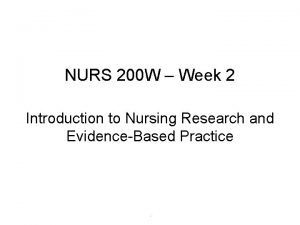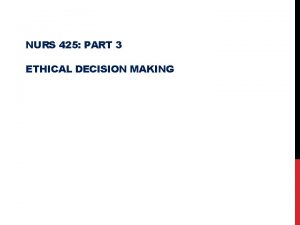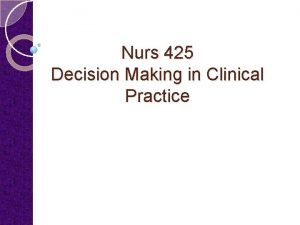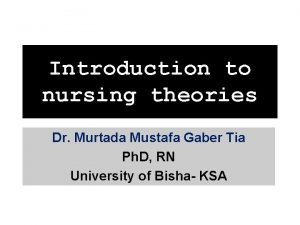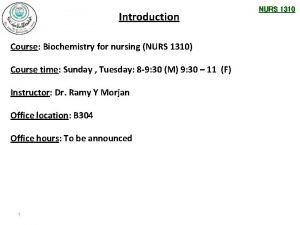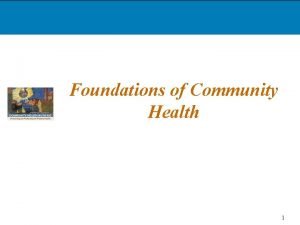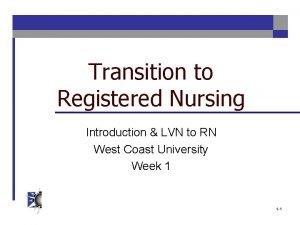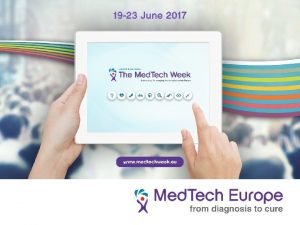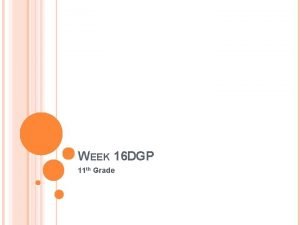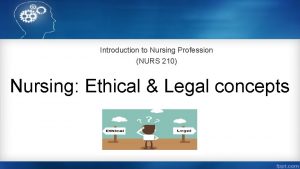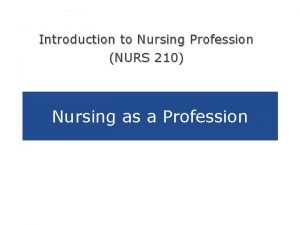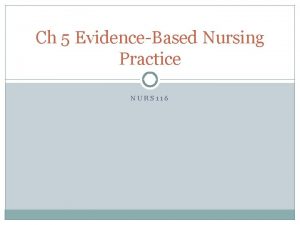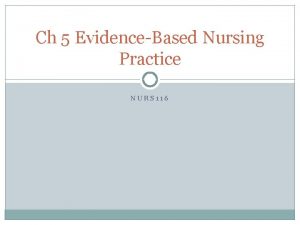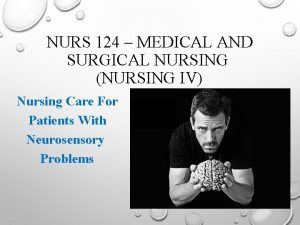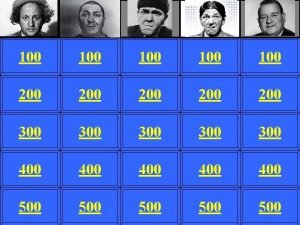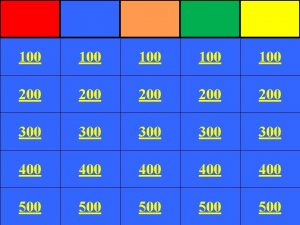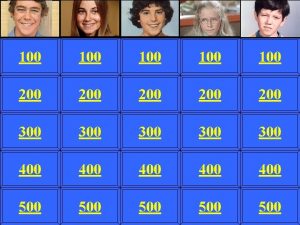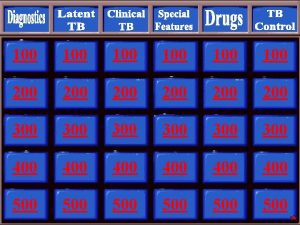NURS 200 W Week 2 Introduction to Nursing































- Slides: 31

NURS 200 W – Week 2 Introduction to Nursing Research and Evidence-Based Practice .

What is nursing research? To search again To examine carefully Diligent and systematic inquiry Discovery – a “spirit of inquiry” Goal is to develop an empirical (scientific) body of knowledge for a discipline essential for evidence based practice! 2

3

Why is research important for evidence-based practice? Develops empirical knowledge base Identifies best practices that are based on clinical practices AND research Improves outcomes for: Ø Ø Ø Patient and family Nurse Health care system 4

What role does research have in implementing an evidenced-based nursing practice? Description – identify and understand topics where little is known (health literacy in the rural America) Explanation – explains the interaction between concepts (health literacy and frequent ED visits) Prediction – estimate likelihood that an outcome will occur (low health literacy and % of admission following ED visit) Control – experimental designs; maintaining consistency between variables (study focused only on Type 2 DM patients with low health literacy compared to those with average literacy) - 5

Description Example Omari (2009) investigated the perceived needs of adult relatives of hospitalized ICU patients Ø Convenience sample of 139 family members – questionnaires Identified the top 10 needs of families Ø none of these needs were being met

Explanation Example Kagan et al. (2009) studied the relationship between nurses’ perceived knowledge and behaviors about blood-borne pathogens (BBP) Ø 180 nurses – questionnaires Perceived knowledge about BBP was positively correlated with attitude toward standard precautions and with handwashing compliance Knowledge was not correlated with patient avoidance

Prediction Example Chang & Mark (2009) investigated potential predictive variables for severe and non-severe medication errors Ø Data collected from 279 units in 146 hospitals Found that more BSN-prepared nurses predicted fewer severe med errors Also, units with more experienced RNs and better support services had more non-severe med errors

Control Example Twiss et al. (2009) hypothesized that an exercise intervention would improve muscle strength and balance and prevent falls in breast cancer survivors with osteoporosis Ø Randomly assigned 223 women to either exercise group or control group Found significant improvements in muscle strength and balance Found decrease in falls (but not significant)

What is the history of nursing research? Nursing research has evolved slowly over the years. Nursing research began in the 19 th century with Florence Nightingale – Crimean War Clinical research is the current major focus of nursing research and will continue to be so throughout the 21 st century. 10

Nursing Research: 21 st Century 2000—Healthy People 2010 2000—Biological Research for Nursing 2002—Joint Commission revised policies to support evidence-based care. 2004—Worldviews on Evidence-Based Nursing 2010—Healthy People 2020 11

21 st Century 2005—AHRQ Agency for Healthcare Research and Quality guidelines and priorities Ø www. ahrq. gov 2005—NINR Natl Institute of Nursing Research priorities Ø www. nih. gov/ninr Ø Look at this site. What are the current areas of focus for the NINR? 2006—Revised AACN American Associaiton of Colleges of Nursing position statements on nursing research 12

How is nursing knowledge acquired? Traditions – changing bed linens daily Authority – charge nurse on a unit Borrowing – knowledge from other disciplines Trial and Error Personal Experience – Benner’s Model – novice to expert level of experience Role Modeling – clinical preceptor or mentor Intuition – source of knowledge cannot be fully explained, “gut feeling” Reasoning – inductive or deductive 13

The Quality and Safety Education for Nurses (QSEN) An initiative focused on developing the requisite knowledge, skills, and attitude (KSA) statements for each of the competencies for prelicensure and graduate education. www. qsen. org – check out this site QSEN Competencies Ø Ø Ø Patient-Centered Care Teamwork & Collaboration Evidence Based Practice Quality Improvement Safety Informatics 14

How and why do researchers utilize empirical knowledge? Empirical knowledge is gained by employing Quantitative research = numbers Qualitative research = language (qualitative with an “L” is the type of research that collects and analyzes words or language) Ø Outcomes research = system level quality and effectiveness Ø Ø Empirical knowledge is essential for the delivery of high-quality, safe patient and family nursing care (QSEN competencies) 15

Quantitative Research Formal, objective process Involves measurement & numerical data Philosophy: logical positivism Ø Ø Ø Truth is absolute A single reality exists Deductive reasoning Purposes: test hypotheses, determine cause & effect, identify relationships among variables

What are the categories of quantitative research? Descriptive – measures what is Correlational – how concepts relate to each other Quasi-experimental and Experimental – Manipulate or control one aspect of a situation to examine the effect. 17

Qualitative Research Systematic, subjective approach Involves non-numeric data Philosophy: holistic, interpretive Ø Ø Ø Truth is dynamic Multiple realities exist Inductive reasoning Purpose: investigate human experiences and interactions

What are some categories of qualitative research? Phenomenological – describe an experience Grounded theory – formulate and test a theory Ethnographic - in depth study of a culture Exploratory-descriptive – describe a topic and promote understanding Historical research – an analysis of events to provide understanding 19

Characteristics of Quantitative and Qualitative Research Methods 20

What is the focus of outcomes research? Examines the results of care and the changes in health status. Focus can be: Ø Ø Ø Patients and families Providers Health care systems Practice changes Policy development 21

Why utilize evidence-based practice guidelines? Provide high-quality, cost-effective health care Allow for synthesis of knowledge needed for interventions and practice Ø Ø Guidelines Standards Protocols Policies 22

23

Nurses with a Bachelor of Science Degree… Are knowledgeable about the research process and have skills in reading and critically appraising studies. The QSEN competencies identify such knowledge and skills as being essential for pre-licensure students. Should be prepared to actively participate in Evidence Based Practice. 24

Roles of Nurses in Research

What is the primary role of an entry level nursing researcher? Identify research problems Assist with data collection Critique research studies Summarize research findings for use in practice 26

Evidence-Based Practice Best Research Evidence evidence Clinical expertise Patient values and needs High-quality, cost-effective health care

Research Example… As a new nursing researcher you would like to learn more about the research process and identify credible resources. You decide to examine the problem of medication adherence and the use of a medication reconciliation process for patients who are newly diagnosed with hypertension. What are the steps to Evidence Based Practice? 28

EBP Step by Step (Melnyk et al. , 2010) Step 0: Cultivate a spirit of inquiry. Step 1: Ask a clinical question in PICOT format. Step 2: Search for the BEST evidence Step 3: Critically appraise the evidence Step 4: Integrate the evidence with clinical expertise and patient preferences and values Step 5: Evaluate the outcomes of practice decisions based on the evidence Step 6: Disseminate the EBP results 29

Identify the Research Population, Intervention, Comparisons, and Desired Outcome and Time (The PICO(T) Question) P—Population -patient with hypertension I—Intervention - implementing medication teaching C—Comparison -compare patient outcomes for patient who receive teaching to those for a patient who does not O—Outcomes - increased adherence leads to decrease in blood pressure (T) - Time (may not always be a part of the study) or (S) – Setting (may not always be part of the study) 30

PICO Statement for Research Example… This is an example of an intervention type PICO question. In patients with hypertension how does medication teaching compared to no medication teaching increase medication adherence and lowered BP? 31
 Nurs 200
Nurs 200 100 + 200 + 300
100 + 200 + 300 Nurs 425
Nurs 425 Nurs 425
Nurs 425 Week by week plans for documenting children's development
Week by week plans for documenting children's development 200+200+100+100
200+200+100+100 200 + 200 = 400
200 + 200 = 400 200+200+300
200+200+300 200 + 200 + 300
200 + 200 + 300 100 200 300
100 200 300 100 + 100 + 200
100 + 100 + 200 Functional method nursing
Functional method nursing Nursing assessment of ocd
Nursing assessment of ocd Nursing care plan of cataract
Nursing care plan of cataract Conclusion of nursing process
Conclusion of nursing process Nursing process in psychiatric nursing
Nursing process in psychiatric nursing Type of position in nursing
Type of position in nursing Classification of nursing theories
Classification of nursing theories Introduction of biochemistry in nursing
Introduction of biochemistry in nursing Eight characteristics of community health nursing
Eight characteristics of community health nursing Nursing research definition
Nursing research definition Lpn vs lvn
Lpn vs lvn Conclusion of bed making ppt
Conclusion of bed making ppt Intro paragraph outline
Intro paragraph outline Htcondor week
Htcondor week Htcondor vs slurm
Htcondor vs slurm Ana ascenção e silva
Ana ascenção e silva Reading arthur miller's play the crucible
Reading arthur miller's play the crucible Dgp week 8
Dgp week 8 Compound words with coat
Compound words with coat Dgp week 16
Dgp week 16 Dgp week 12 answers
Dgp week 12 answers
